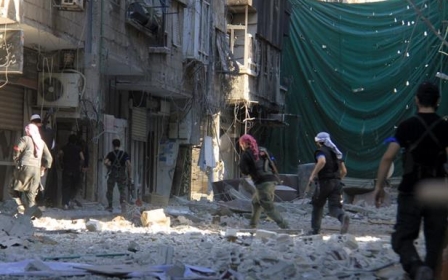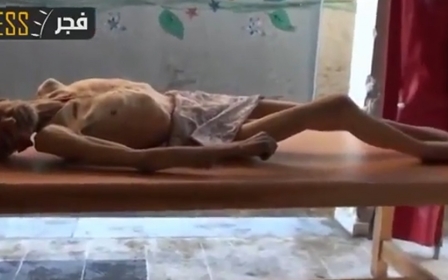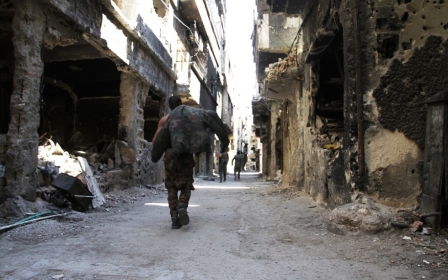Unravelling the media spin on Yarmouk

When the Islamic State (IS) group entered Yarmouk in southern Damascus last week, the Palestinian refugee camp was thrust back into the media spotlight.
Caught between the rockets of Syrian government forces and violent militants who have seized territory in northern Syria and Iraq, factions inside Yarmouk, chiefly the Palestinian group Aknaf Beit al-Maqdis, fought fierce gun battles with IS.
With concern over the fate of the camp growing, the PLO sent a delegation from the West Bank to Syria to discuss the plight of the refugees with Syrian authorities. An initial statement from PLO official Ahmad Majdalani said that Palestinian factions had agreed to cooperate with Syrian government forces inside the camp to counter IS.
However, another statement released shortly afterwards from the PLO leadership in Ramallah contradicted this, saying that they refused to be drawn into military actions.
Saeb Erekat, the PLO’s chief negotiator, supported the move and stressed that Palestinian factions within Yarmouk have refrained from meddling in “a conflict that isn’t theirs”.
Residents of Yarmouk, however, offer a very different version of events.
“Palestinian militias allied to Bashar al-Assad like the Popular Front for the Liberation of Palestine-General Command [PFLP-GC] are the ones who dragged the camp into the Syrian conflict,” 30-year-old journalist Ahmad, a resident of the camp, told Middle East Eye via Skype on Thursday.
“Before, the camp was a safe haven, a neutral zone for people in the areas around it," Ahmad said. "These militias, led by PFLP-GC’s Ahmad Jibril, are the ones who began kidnapping and arresting activists within and around the camp and handing them over to the regime.”
Anwar Abdul Hadi, a PLO official based in the government-controlled capital of Damascus, said on Sunday that 2,000 people were evacuated from the camp to the capital under the protection of the Syrian army.
"Around 400 families managed to leave the camp on Friday and Saturday via two secure roads to the Zahira district which is under army control," he said, adding that most were taken to government shelters and hospitals in Damascus.
Shaml Media, a Palestinian media network in Syria, was the first to contest the PLO’s claims, tweeting out that only 180 people left Yarmouk.
Sources within the camp who spoke to various humanitarian organisations within Yarmouk told MEE that approximately 200 people left on the day the PLO issued its statement.
“They weren’t evacuated,” said Ahmad. “I can confirm that the regime forces did not offer a safe passage for the ‘evacuation’ of the refugees. Rather, the refugees took refuge outside the camp.”
Displacement from the camp
Since IS entered Yarmouk just over a week ago, a total of 4,000 residents had fled to the nearby neighbourhoods in the besieged southern Damascus area of Babila, Yalda and Beit Sahm.
Salim Salamah, who is based in Sweden and head of the Palestine League for Human Rights-Syria, admitted to the confusion surrounding the news of the residents fleeing.
“We need to distinguish between two things,” he said. “The displacement of the people from the camp within southern Damascus and the displacement of the people from the camp to outside, who are now in the regime-controlled Damascus.”
Ahmad said that Yarmouk, a 2.11-square-km area that used to house 160,000 people that are now reduced to around 14,000, had entrances to the north sealed off by government forces and a few roads to the south that led to neighbourhoods controlled by armed opposition factions, most of which have signed truces with the Syrian government.
It remains unclear as to how exactly the 200 residents managed to make it outside southern Damascus to the government-controlled part of the capital.
“No one goes to the regime-controlled entrances,” Ahmad explained. “It’s just not checkpoints they’ve erected; it’s an entire battleground, with snipers ready to shoot at anything moving.”
"Most of the people that managed to leave to Yalda and Babila are now living in schools or in the streets," he added.
“The roads are accessible as long as there is no aerial bombardment,” said Salamah. “Of the people who fled since IS invaded the camp, 2,500 people from Yarmouk are now in Yalda, 1,000 in Babila, and 500 in Beit Sahm.”
Military entry will bring further death
Anger at the PLO has risen in the camp, especially since the announcement that Palestinian officials would be meeting with authorities who they see as responsible for the camp’s ongoing blockade.
“We have been under siege for years, and all the humanitarian aid is delivered to Beit Sahm and Babila,” said one resident of the camp. “We thank Ahmad Majdalani for the presents he has given us in the past few days,” he added sarcastically, referring to the rockets that Syrian military planes have dropped on the camp.
Fawzi Hameed, the head of the civil society organisations in Yarmouk, stated that a military solution would only bring more devastation.
“We demand [that] the PLO and those in Ramallah find a solution to get us out of this situation … and we stress that the entry of the military will bring about further death and destruction and is not the solution,” he said.
Presence of IS exploited by factions for media
Analysts say that the renewed attention that Yarmouk is now under masks the complicity of both pro- and anti-government factions that contributed to its demise.
“Everyone is trying to profit from the camp’s suffering,” Ahmad said. “They all want to turn Yarmouk into a Kobane to achieve their victories on the backs of the flesh of the civilians,” referring to the Kurdish city that garnered major media attention after IS overran the city and the US-led military coalition started a bombing campaign against the militants.
Speaking through Skype, Ahmad's otherwise solemn voice halted a few times as the whining of a Syrian military plane sounded overhead. After a couple of loud booms, he apologised and said he would call back later as he had to move to the lower ground of the house he was in.
“One thing we have to be mindful of is that the presence of the Islamic State in Yarmouk provides other sides, the opposition factions and the government regime alike, to exploit the media in a favourable way,” he said.
Different rival opposition factions have issued statements regarding their role in fighting IS alongside Aknaf Beit al Maqdis.
“If Jaish al-Islam [a Saudi-backed faction led by Zahran Alloush that operates in eastern Ghouta] wanted to fight IS they could have entered from Hajr al-Aswad and attacked them from behind,” Ahmad laughed. “There are limited battles on the outskirts but they did not enter the camp - this is all for the media. Also, Ahrar al-Sham did not get involved.”
Meanwhile the media has turned a blind eye to the government forces’ role in starving Yarmouk’s residents in favour of intensive reporting on the army’s alleged military proposition to enter the camp in order to repel IS. Yet Yarmouk’s residents maintain that the biggest threat they encounter is from the Syrian military airstrikes on the camp.
“Media sources have reported that there are massacres and mass beheadings in Yarmouk,” said Abu Ahmad Huwari, the secretary-general of the Palestinian National Body for Yarmouk camp, pointing out that this has caused families who were previously displaced from the camp to panic.
“We in Yarmouk assert that there is no truth to these reports, and we confirm as civil society organisations that there are airstrikes that kill civilians, and that we will remain in the camp in order to ensure a dignified life and to ensure the return for our families,” he declared. “We will not leave the camp despite the barrel bombs or the gun battles. We will only leave if we go back to our land in Palestine. For now, we demand a safe passage so that food and medical supplies can enter for our people.”
Aerial bombings biggest danger
Ahmad dismissed claims of an IS takeover of the camp.
“Here I am, talking to you and smoking,” he said. “I can go down to the store in the street and buy a pack of cigarettes, and I won’t be beheaded by IS because I am not living in their ‘state.’”
“They didn’t impose their rule and declare Yarmouk as part of their caliphate,” he added. “Their presence should not be confused with controlling the camp.”
“We’ve been talking for a couple of hours now,” he continued. “Have you heard me at one point say with fear, oh no, I must hide because a member of IS just passed by? The airstrikes remain the biggest danger to the civilians.”
The bombings target residential areas as it is too risky to target the flashpoints where opposition groups are located in close proximity to government forces.
“More than 30 barrel bombs targeted the camp in the last nine days,” Salim Salamah said. “On Wednesday night 16 barrel bombs fell on the camp, including one that targeted Palestine Hospital. These aerial bombardments are extremely destructive and are in no way comparable to the ground invasion of IS.”
“If medical and food supplies don’t enter the camp within the next 48 hours, the result will be beyond tragic,” he said.
New MEE newsletter: Jerusalem Dispatch
Sign up to get the latest insights and analysis on Israel-Palestine, alongside Turkey Unpacked and other MEE newsletters
Middle East Eye delivers independent and unrivalled coverage and analysis of the Middle East, North Africa and beyond. To learn more about republishing this content and the associated fees, please fill out this form. More about MEE can be found here.





